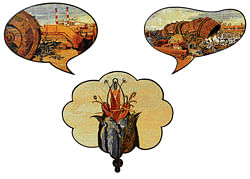Mutant development
It was after several years that one saw an extensive and important exhibition of Babu Eshwar Prasad (Sumukha Gallery, February 20 to March 13).
His work is still preoccupied with the landscape of our reality while at the same time continuing and altering its aesthetic and thematic focus. Familiar with Prasad’s earlier paintings complemented by an occasional sculpture and video, one may have initially missed the muted, luminous translucency of his layered acrylics that evoked ambiguous complexities of our perception amid outer and inner spaces.
Soon enough though, one could notice that pervasive simultaneity rediscovered in merged sequences of sights in a mutually enhancing interaction of photographic realness to the effect of plasticity, symbolic restructuring of the actual and a quintessential painter’s sensitivity. Such qualities ensured that, unlike often in recent cutting-edge art which tends to limit itself to statements and pointing to mechanisms and attitudes, the spectator came close to a cathartic experience thanks to Prasad’s capacity to evoke an ominous beauty whose visual sensations gradually led towards more conscious realisations.
Titled “Skin of the Earth”, the show centred on the now drastically evident condition of the ravaged soil around here epitomising the perilous rush to economic growth. The way the artist approaches it, in fact, considers the earth as the site and the body of what is happening as well as a metaphor, a participant in and a victim of the process who becomes a witness speaking for the state of things and revealing the dangers behind.
These corporeally intuited premonitions are particularly strong in the digital prints with their proximity to the texture and red colour of iron-rich soil which always remains bare, both as the building material for anthills and for man-driven urban construction or ore mining. Throughout, the pan-organic pressure to erect, expand and exploit manifests its life affirming yet self-destructive core and consequences while contrasting-comparing-blending the human stratum with the natural.
Dense agglomerations of ceaselessly industrious anthills almost mirror the tight pulse of high-rise residential complexes, whereas habitations of people observed from a distance turn into a virtual hive over which dragonflies hover as alter egos of airplanes.
A termite mound and old-fashioned anvil create a hybrid monument to the situation, its imposing loftiness aspirational in the manner of mundane manual perseverance of people but also similarly fragile, perhaps doomed. The images become yet longer horizontally when capturing, with a somewhat cinematic effect, an endless unfolding of mutated earth surface and its exposed, wounded belly, the flights of the unnaturally grey or yellow sky, the windings of the hilly scenery undulations and the roads invaded into by omnipresent excavations and the ever stretching junkyards of outdated machinery.
Whilst countless earthmovers busy themselves amid the countryside appearing to be like termites, piles of industrial or construction scrap and enormous pipes acquire the look and behaviour of alien birds and worms. The impact of prevailing is generated through image elongation over seamlessly merged similar scenes and motifs that as though open out and reflect one another as well as through disruptions and insertions into their character.
The related videos wrap one’s impression in a slow, nearly meditative dynamism emphasised by the formal finesse of their abstract aspect. The four canvases clarify, sometimes single out certain elements, beauty, nostalgia for the past and mystery of the future, transposing those into signs and metaphors. Maybe the most admirable is the three-part, shaped painting in wood inlay the meaning of whose substance reverberates in the symbolism of the imagery where a vegetal motif from Hieronymus Bosch, a personification of the preciousness of nature, in comic strip bubbles laments its wrecked condition.
Cultured traditionalism
The Contrivance group of 15 Bengali artists from different parts of the country celebrated their 35th anniversary of its Kolkata founding with a large exhibition at the CKP (March 6 to 12).
Mostly, but not only, senior members of a Modernist and even earlier anchoring, they uniformly displayed sound technical and compositional skills combined with a formalist orientation around vital but not confrontationally presented situations and issues with predominantly pleasing images framed often in variants of broader idioms characteristic to the region of their origin.
While Revivalist echoes were lucid (Mohi Paul, Tanushree Gosh) or subdued under a comparatively fresher language (Animesh Biswas, Malay Dutta, Nripen Nath, equally to classical modern patterns in sculpture, graphics and painting (Narayan Sutradhar, Pradip Sur, Sushanta Roy, Sudip Saha) including abstraction (Ajay Das), greater degrees of innovation were merely apparent – gracefully decorative (Bikas Mukherjee, Dipankar Mukherjee, Nirmal Kumar Mallick) or surface-bound in their dramatic arrangements (Swarup Nandi, Swapan Dendra, Srimanta Das Joydeep Chatterjee). One wished they had more courage.
